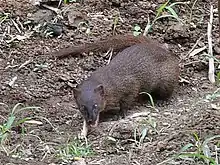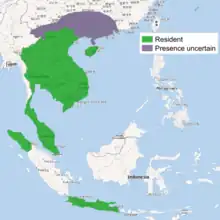Javan mongoose
The Javan mongoose (Urva javanica) is a mongoose species native to Southeast Asia.[1]
| Javan mongoose | |
|---|---|
 | |
| Scientific classification | |
| Domain: | Eukaryota |
| Kingdom: | Animalia |
| Phylum: | Chordata |
| Class: | Mammalia |
| Order: | Carnivora |
| Suborder: | Feliformia |
| Family: | Herpestidae |
| Genus: | Urva |
| Species: | U. javanica |
| Binomial name | |
| Urva javanica (É. Geoffroy Saint-Hilaire, 1818) | |
| Subspecies | |
|
U. j. javanica | |
 | |
| Javan mongoose range | |
Taxonomy
Ichneumon javanicus was the scientific name proposed by Étienne Geoffroy Saint-Hilaire in 1818.[2] It was later classified in the genus Herpestes, but all Asian mongooses are now thought to belong in the genus Urva.[3]
In the 19th and 20th centuries, several zoological specimens were described, which are now considered subspecies:
- Herpestes exilis by Paul Gervais in 1841 was a specimen from Tourane in Vietnam.[4]
- Herpestes rafflesii by John Anderson in 1875 was a specimen from Sumatra.[5]
- Mungos rubifrons by Joel Asaph Allen in 1909 were eight adult specimens collected around Wuzhi Mountain in Hainan Island, China.[6]
- Mungos exilis peninsulae by Ernst Schwarz in 1910 was a skin and a skull of a mongoose collected in Bangkok.[7]
- Mungos siamensis by Cecil Boden Kloss in 1917 was a skin of an adult female mongoose collected in northern Thailand.[8]
- Mungos parakensis by Kloss in 1917 was a skin and a skull of an adult female mongoose from the vicinity of Taiping, Perak in Peninsular Malaysia.[9]
- Herpestes javanicus tjerapai by Henri Jacob Victor Sody in 1949 was an adult male mongoose collected in Aceh Province, Sumatra.[10]
The small Indian mongoose (U. auropunctata) was once considered to be a subspecies of the Javan mongoose.[11] Genetic analysis of hair and tissue samples from 18 Javan and small Indian mongooses revealed that they form two clades and are distinct species. The Salween River in Myanmar is probably a barrier between the two species.[12] Analysis of mitochondrial DNA of Urva species revealed that the Javan mongoose forms a sister group with the Indian grey mongoose (U. edwardsii). The Javan mongoose probably evolved about 0.5 million years ago in the middle Miocene.[13]
Characteristics
The Javan mongoose's fur is ferruginous to sepia and rich tawny brown on the back.[5][8] It has short hairs on the ears. Its tail is tapering.[5]
Distribution and habitat
The Javan mongoose is native to Myanmar, Thailand, Cambodia, Vietnam, Laos, Peninsular Malaysia and the Indonesian islands of Sumatra and Java, where it lives up to an elevation of 1,800 m (5,900 ft). Its presence is uncertain in China.[1] In Thailand, the Javan mongoose was photographed by camera traps in a variety of habitats, including degraded mixed deciduous forest, dry evergreen and dry dipterocarp forests, as well as in abandoned plantations and pineapple fields.[14]
Invasive species
In Europe, this species has been included since 2016 in the list of Invasive Alien Species of Union concern.[15] This means that this species cannot be imported, bred, transported, commercialized, or intentionally released into the environment in the whole of the European Union.[16]
Behaviour and ecology
The Javan mongoose is mostly solitary; males sometimes form social groups and share burrows. Females are pregnant for up to 49 days and give birth to a litter of 2–5 young. Males can potentially become sexually mature at the age of 4 months.
Javan mongooses eat mostly insects but are opportunistic feeders and will eat crabs, frogs, spiders, scorpions, snakes, small mammals, birds and eggs.
Threats
In Sumatra, the Javan mongoose is wild-caught for the pet trade. It was the most commonly offered species at wildlife markets in Medan during surveys between 1997 and 2001.[17] Despite being hunted heavily in Laos, Thailand, and Vietnam, it is commonly seen in suburban areas.[1]
References
- Chutipong, W.; Duckworth, J. W.; Timmins, R.; Willcox, D. H. A. & Ario, A. (2016). "Herpestes javanicus". IUCN Red List of Threatened Species. 2016: e.T70203940A45207619.
- Geoffroy Saint-Hilaire, É. (1818). "De l'Ichneumon. Ichneumon pharaon". In Jomard, E. F. (ed.). Description de l'Égypte, ou, Recueil des observations et des recherches qui ont été faites en Égypte pendant l'éxpédition de l'armée française. Vol. Tome II. Paris: l'Imprimerie Royale. pp. 137–144.
- "ASM Mammal Diversity Database". www.mammaldiversity.org. Retrieved 2021-07-08.
- Gervais, P. (1841). "Observations géologiques et anatomiques sur diverses espèces de Mammifères nouveaux ou peu connus". Extraits des procès-verbaux des séances. 6: 101–103.
- Anderson, J. (1875). "Description of some new Asiatic mammals and Chelonia". The Annals and Magazine of Natural History; Zoology, Botany, and Geology. 4. 16 (94): 282 285.
- Allen, J. A. (1909). "Further notes on mammals from the Island of Hainan, China" (PDF). Bulletin of the American Museum of Natural History. 26 (17): 239–242.
- Schwarz, E. (1910). "Two new Oriental Viverridae". The Annals and Magazine of Natural History; Zoology, Botany, and Geology. 8. 6 (32): 230–232.
- Kloss, C. B. (1917). "On a new Mongoose from Siam". The Journal of the Natural History Society of Siam. 2 (3): 215–217.
- Kloss, C. B. (1917). "On the mongooses of the Malay peninsula". Journal of the Federated Malay States Museums. 7: 123–125.
- Sody, H.J.V. (1949). "Notes on some Primates, Carnivora, and the Babirusa from the Indo-Malayan and Indo-Australian regions (with descriptions of 10 new species and subspecies)". Treubia. 20 (2): 121–190.
- Wozencraft, W. C. (2005). "Species Herpestes javanicus". In Wilson, D. E.; Reeder, D. M. (eds.). Mammal Species of the World: A Taxonomic and Geographic Reference (3rd ed.). Johns Hopkins University Press. p. 567–570. ISBN 978-0-8018-8221-0. OCLC 62265494.
- Veron, G.; Patou, M.L.; Pothet, G.; Simberloff, D. & Jennings, A.P. (2007). "Systematic status and biogeography of the Javan and small Indian mongooses (Herpestidae, Carnivora)". Zoologica Scripta. 36 (1): 1–10. doi:10.1111/j.1463-6409.2006.00261.x. S2CID 84419834.
- Patou, M. L.; Mclenachan, P. A.; Morley, C. G.; Couloux, A.; Jennings, A. P. & Veron, G. (2009). "Molecular phylogeny of the Herpestidae (Mammalia, Carnivora) with a special emphasis on the Asian Herpestes". Molecular Phylogenetics and Evolution. 53 (1): 69–80. doi:10.1016/j.ympev.2009.05.038. PMID 19520178.
- Chutipong, W.; Tantipisanuh, N.; Ngoprasert, D.; Lynam, A.J.; Steinmetz, R.; Jenks, K.E.; Grassman Jr., L.I.; Tewes, M.; Kitamura, S.; Baker, M.C.; McShea, W.; Bhumpakphan, N. & Sukmasuang, R. (2014). "Current distribution and conservation status of small carnivores in Thailand: a baseline review". Small Carnivore Conservation. 53: 96–136.
- "List of Invasive Alien Species of Union concern - Environment - European Commission". ec.europa.eu. Retrieved 2021-07-27.
- "REGULATION (EU) No 1143/2014 of the European parliament and of the council of 22 October 2014 on the prevention and management of the introduction and spread of invasive alien species".
- Shepherd, C.R.; Sukumaran, J. & Wich, S.A. (2004). Open season: an analysis of the pet trade in Medan, Sumatra, 1997–2001 (PDF) (Report). Petaling Jaya, Selangor, Malaysia: TRAFFIC Southeast Asia.
Further reading
Tseng, Z.; Flynn, J. (2015). "Convergence analysis of a finite element skull model of Herpestes javanicus (Carnivora, Mammalia): Implications for robust comparative inferences of biomechanical function". Journal of Theoretical Biology. 365: 112–148. Bibcode:2015JThBi.365..112T. doi:10.1016/j.jtbi.2014.10.002. PMID 25445190.
